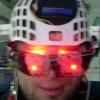I will try to answer your questions
First of all on the page is only small part of info i did not have time to finish it (many other projects
I did not expect that it will be of such interest .
I am not good in electronics. What for does he use current regulator? His scheme is not understandable as well as how he made the electrodes. Did he attach sponges to the foil cut from beer can? Also I do not understand why he adds a test lamp to the scheme. The new battery will work for some time and he can later measure the current with a digital multimeter or by attaching the lamp from an old pocket lantern.
Also it is strange that he attached electrodes to the piece of cloth. If they are not detachable from it, he cannot use electrodes on other areas of head where the distance between electrodes is larger or smaller. He presents only one way of application of electrodes to head. Are there any other ways? Who has already tried tDCS? Any experiences?
IS it possible to use nickel-magnesium rechargeable battery instead of the alkaline one?
my knowledge of electronic is only very base . I try to built tdcs simplest way from available material.Simlest in not safest but for the purpose it is sufficient.
current regulator- because the resistence of brain+skin is very variable , if not regulated curent will change quickly
Electrodes - this part is not wiriten yet , i still try to find better way to built it.
The electrodes taht i uset is brusehed beercan foil (it has nonconductive layer tat must by brushed away) stitched between 2 layers of sponge like ths http://aao.cz/foto/71049.jpg
The diode is only for test battery ,circut not need it (there were lot of space in the box tahat i fill it)
Pres the buton is fastest than finding multimeter, lamp from lanthern is for higer current.
Electrodes is on plastic and there is detachable , conection is made from this http://www.broz-brac...ct_280_1855.jpg
distance, areas
I made it for my head, position is fixed - for one user/head only.
Fixed position is for safety reasons to avod problems like changet polariry , wrong place of stimulation ..
čkal I get it that every stand by their head
battery - you can use use nickel-magnesium rechargeable battery instead there is no problem


















































